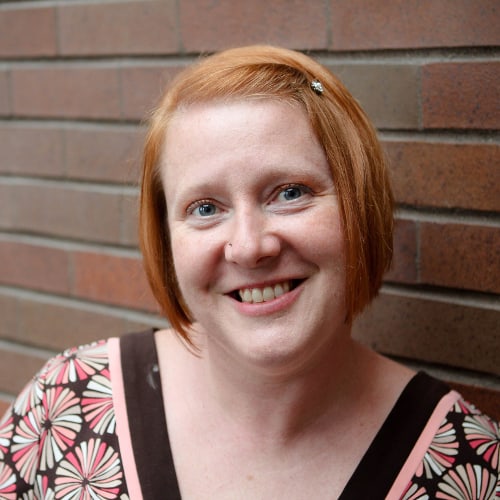3 Lessons Learned Building Student Digital Portfolios

Deep breath. Facilitate don’t dominate. Loud is ok. Ask more questions. Redirect. Move obstacles. Update the website with this list of due dates.
This is my internal monologue today, as my eighth-grade students are building their digital portfolios and beginning their culminating Passion Projects. It is May, and there are three days of state math assessments, a long weekend and Spring Fever to contend with, yet I am still feeling optimistic.
Last year, my students created websites to showcase their Passion Projects. I was so impressed with the outcome that I decided this past fall that my new crew would have digital portfolios of all of their work this year.
Ahhhh…the best-laid plans. Here’s what I’ve learned this year from this endeavor.
Old Habits Are Hard to Break
Project Based Learning (PBL) isn’t the same as doing a project. I’m not usually a big fan of labels, but it is an important distinction. Projects are completely legitimate ways to summatively assess your students’ learning. Project Based Learning is (according to Buck Institute for Education, my go-to guide to all things PBL) “a teaching method in which students gain knowledge and skills by working for an extended period of time to investigate and respond to an authentic, engaging and complex question, problem or challenge.”
In my case, I call these “burning questions,” and ask that my students form one around a nonfiction topic that they are passionate about. The goal for May will be to find the answer(s) to their burning question through a series of self-designed activities.
Sounds good so far, right? Except that isn’t how it really goes. It really involves a good 20 kiddos who don’t know what they want to do, and it is ridiculously tempting to simply suggest a topic for students, help them frame a burning question and know that they will end up where you predict. But, that’s not the point now, is it? The learning is in the exploration, the formulation and the experimentation of the self-designed activities.
When I used to (as in last year) just jump in, I was taking away the learning that could be gained in productive struggle. This is a bit of a theme for me this year, as I’ve noticed in my own teaching, and others as well, that we teachers can sometimes cling to our old habits of being the knowledge giver, instead of the tour guide, for student learning. I’m still working on this, particularly for those students who are slower to formulate a plan than I want them to be.
How To Eat An Elephant
To say that grading three self-directed activities each for 133 students, evaluating 133 websites and reading 133 book reviews is overwhelming is an understatement. So, how do I “eat this elephant?” The answer, as the old adage goes, is “one bite at a time.” The main factor in my grading is creating or finding the best rubrics to keep my job as an evaluator as simple as possible, allowing me to arrive at a number that is important to many people, but not to me.
I’m not a grades kind of girl–at least not anymore. I’d personally love to throw out grades (as these reformers are doing), but in my district that’s impossible. However, I can minimize the emphasis by giving quality feedback in the sections of the rubric labeled “Mrs. Chandler’s Comments.” The more specific, constructive and kind feedback I can give students, the more likely they will retain the learning from the experience.
The grading is holistic and also based on knowledge I accumulate as I observe students as they work. A very important aspect of handling this quantity of work is that I grade pretty much continually in May and June. It isn’t as bad as it sounds, and I utilize ready-to-go resources, like those I mention here.
Basically, as students finish one of their self-directed activities, I assess it, and they are able to learn as they go, often making adjustments that improve the number grade and the product before it becomes a part of their public performance in June.
For example, we technically haven’t started these projects until this upcoming week, yet Madison (a student who is trying to find out how to play college softball) has already emailed a softball player who plays for Auburn and set up an interview. The entire purpose of my Passion Projects, and the digital portfolios, is to embolden students to do just this: charge ahead with confidence and authentic experiences as 21st-century, self-directed learners.
Paperless…Mostly
One of the goals of the digital portfolios is to go paperless. I’m lucky enough to have a class set of Chromebooks (and most of my students bring their devices to class), so it is possible to be paperless. However, I just can’t seem to let go of wanting students to have a hard copy of important papers (though this is certainly a 43-year-old woman problem, not a kiddo problem).
I personally love the action of writing things down and am unable to use a digital calendar–I instead have a series of planners with lots of sticky notes. So I found myself–literally just this week–handing out an overview of the Passion Projects that can be found here on my website. My suspicion that led me to attempt a paperless classroom in the first place was confirmed when I picked up copies from the tables (and one from the floor!) as students filed out.
I’ve had to come to peace with my own inability to go completely paperless, but I do want to honor the intention I began with. Going forward, I’m going to refrain from the mass printing, and instead ask my students what they need. I suspect that there are still some students who want the paper product, but I’m recognizing more and more this generation’s ability to actually see the world differently. Creating a SlideShow on an iPhone seems tedious to me, but to my students, it is not a problem. Typing/texting an entire essay on a device is normal for them, and their texting is considerably faster than their typing.
Instead of beating myself up for some bumps in the road, I’m going to choose to feel self-congratulatory for giving this entire idea a try. I’m learning from year to year, and one of the goals I have for myself is to continue to grow in synthesizing what I want to do with the technology that best fits that need. I know exactly where I’m going to find the way: my students.
For more, see:
- Can Vision Planning Ward Off the Politics of Education?
- Project Management Solutions for the 21st-Century Student
- Three Tips for Stoking the Fires of Overachievers
Stay in-the-know with all things EdTech and innovations in learning by signing up to receive the weekly Smart Update. This post includes mentions of a Getting Smart partner. For a full list of partners, affiliate organizations and all other disclosures please see our Partner page.








Carin Zecca
Thank you for your honesty. I loved reading your post and look forward to following you! Keep on posting and seeing your students through their eyes. It's amazing.